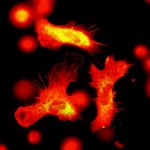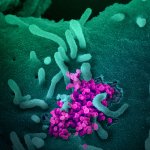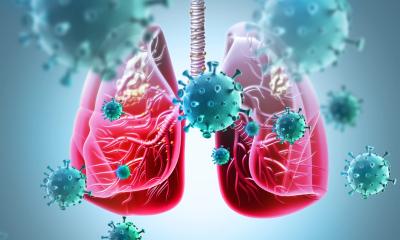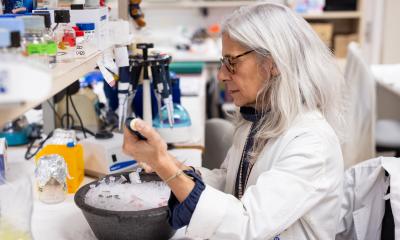News • COVID immunity research
Coronavirus re-infection: what we know so far – and the vital missing clues
As President Trump claims that he is immune to COVID-19 and isolated reports emerge of reinfection, what is the truth about immunity to COVID-19?
Image source: NIH Image Gallery from Bethesda, Maryland, USA, Novel Coronavirus SARS-Cov-2 (50010746961), marked as public domain, more details on Wikimedia Commons
To date, there have been six published cases of COVID-19 reinfection, with various other unverified accounts from around the world. Although this is a comparably small fraction of the millions of people known to have been infected, should we be concerned? To unpick this puzzle, we must first consider what we mean by immunity.
When we are infected with any pathogen, our immune system quickly responds to try to contain the threat and minimise any damage. Our first line of defence is from immune cells, known as innate cells. These cells are not usually enough to eliminate a threat, which is where having a more flexible “adaptive” immune response comes into play – our lymphocytes. Lymphocytes come in two main varieties: B lymphocytes, which make antibodies, and T lymphocytes, which include cells that directly kill the germy invaders.
As antibodies are readily measured in blood, they are often used to indicate a good adaptive immune response. However, over time, antibodies levels in our blood wane, but this doesn’t necessarily mean protection is lost. We retain some lymphocytes that know how to deal with the threat – our memory cells. Memory cells are remarkably long-lived, patrolling our body, ready to spring into action when needed.
Vaccines work by creating memory cells without the risk of a potentially fatal infection. In an ideal world, it would be relatively easy to create immunity, but it’s not always that straightforward. Although our immune system has evolved to deal with a huge variety of pathogens, these germs have also evolved to hide from the immune system. This arms race means that some pathogens such as malaria or HIV are very tricky to deal with. Infections that have spilled over from animals -– zoonotic diseases –- are also challenging for our immune system because they can be completely novel. The virus that causes COVID-19 is such a zoonotic disease, originating in bats.
Recommended article

News • Coronavirus vaccine research
'Immune memory' of blood stem cells could help fight COVID-19
Blood stem cells have a surprising ability. In addition to ensuring the continuous renewal of blood cells, they keep track of past infections so that faster and more effective immune responses can be triggered in the future.
COVID-19 is caused by a betacoronavirus. Several betacoronaviruses are already common in the human population – most familiar as a cause of the common cold. Immunity to these cold-causing viruses isn’t that robust but immunity to the more serious conditions, Mers and Sars, is more durable. Data to date on COVID-19 shows that antibodies can be detected three months after infection, although, as with Sars and Mers, antibodies gradually decrease over time.
Of course, antibody levels are not the only indication of immunity and don’t tell us about T lymphocytes or our memory cells. The virus causing COVID-19 is structurally similar to Sars, so perhaps we can be more optimistic about a more durable protective response – time will tell. So how worried then should we be about reports of reinfection with COVID-19?
The handful of case reports on reinfection with COVID-19 don’t necessarily mean that immunity is not occurring. Issues with testing could account for some reports because “virus” can be detected after infection and recovery. The tests look for viral RNA (the virus’s genetic material), and viral RNA that cannot cause infection can be shed from the body even after the person has recovered.
Recommended article

News • Coronavirus duration questioned
COVID-19 symptoms disappear – while the virus itself remains
In a new study, researchers found that half of the patients they treated for mild COVID-19 infection still had coronavirus for up to eight days after symptoms disappeared. The research letter was published online in the American Thoracic Society’s American Journal of Respiratory and Critical Care Medicine.
Conversely, false-negative results happen when the sample used in testing contains insufficient viral material to be detected – for example, because the virus is at a very low level in the body. Such apparent negative results may account for cases in which the interval between the first and second infection is short. It is hugely important, therefore, to use additional measures, such as viral sequencing and immune indicators.
Reinfection, even in immunity, can happen, but usually this would be mild or asymptomatic because the immune response protects against the worst effects. Consistent with this is that most verified cases of reinfection reported either no or mild symptoms. However, one of the latest verified cases of reinfection – which happened just 48 days after the initial infection – actually had a more severe response to reinfection.
What might account for the worse symptoms the second time round? One possibility is the patient did not mount a robust adaptive immune response first time round and that their initial infection was largely contained by the innate immune response (the first line of defence). One way to monitor this would be to assess the antibody response as the type of antibody detected can tell us something about the timing of infection. But unfortunately, antibody results were not analysed in the recent patient’s first infection.
Another explanation is that different viral strains caused the infections with a subsequent impact on immunity. Genetic sequencing did show differences in viral strains, but it isn’t known if this equated to altered immune recognition. Many viruses share structural features, enabling immune responses to one virus to protect against a similar virus. This has been suggested to account for the lack of symptoms in young children who frequently get colds caused by betacoronaviruses.
However, a recent study, yet to be peer-reviewed, found that protection against cold-causing coronaviruses did not protect against COVID-19. In fact, antibodies recognising similar viruses can be dangerous – accounting for the rare phenomenon of antibody-dependent enhancement of disease (ADE). ADE occurs when antibodies enhance viral infection of cells with potentially life-threatening consequences. It should be emphasised, though, that antibodies are only one indicator of immunity and we have no data on either T lymphocytes or memory cells in these cases. What these cases emphasise is a need to standardised approaches in order to capture the critical information for robust evaluation of the threat of reinfection.
We are still learning about the immune response to COVID-19, and every piece of new data is helping us unpick the puzzle of this challenging virus. Our immune system is a powerful ally in the fight against infection, and only by unlocking it can we ultimately hope to defeat COVID-19.
Source: The Conversation (CC BY-ND 4.0)
19.10.2020











